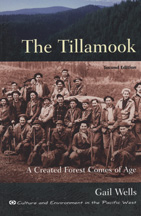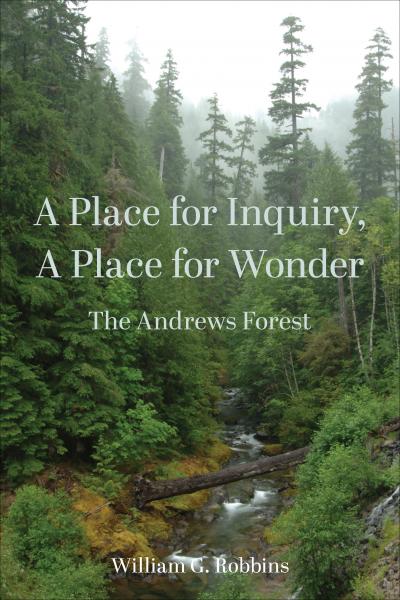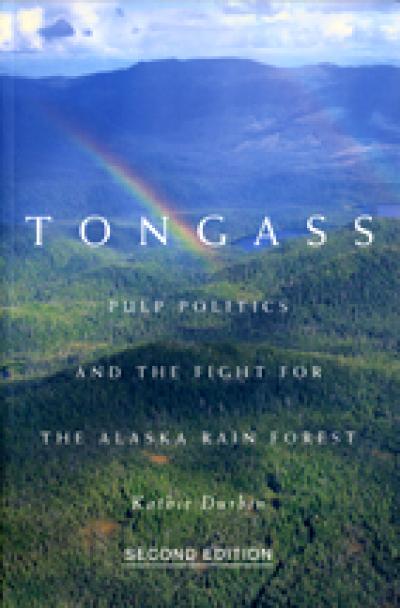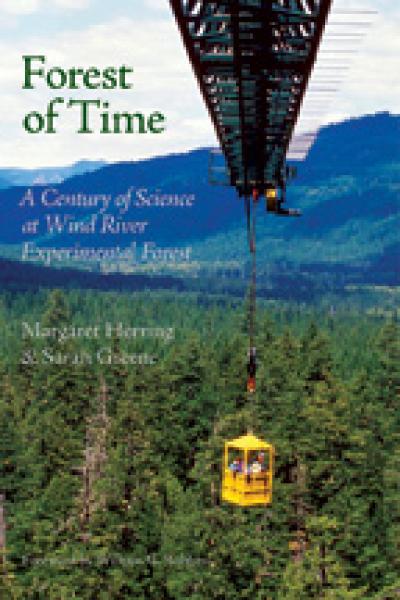
The Tillamook
Gail E. Wells
Debates over the fate of ancient forests have been commonplace in the Pacific West for decades. The Tillamook takes up the question of younger forests, exploring the creation of a managed forest and what its story reveals about the historic and future role of second-growth forests.
It was Oregon's most notorious conflagration-a series of four major fires that struck the Tillamook forest beginning in 1933 and recurred with bizarre regularity through 1951. The fires burned 355,000 acres of virgin forest and became collectively known as the Tillamook Burn. In this engaging history, Gail Wells recounts the story of these famous fires and the cooperative efforts of foresters and ordinary citizens-including thousands of schoolchildren-to get young trees growing again on the burned landscape. It became one of the largest forest rehabilitation efforts ever, resulting in a created forest that promised "timber forever."
Now a state forest, the Tillamook is coming of age at a time when attitudes toward forests have changed and "timber forever" is no longer the guiding principle. In contemplating the Tillamook's fate, Wells traces the historic roots of competing perspectives on forest use and examines the contemporary debate over forest issues. She sees the future of second-growth forests as holding the possibility of a workable synthesis, "a truly stable, sustainable, and humane relationship with our forests."
In a new epilogue, Wells updates the story of the Tillamook five years after her book was first published, and explains why the fate of the forest remains uncertain.
About the author
Gail Wells is the author of The Tillamook: A Created Forest Comes of Age and co-author of Lewis and Clark Meet Oregon’s Forests. She worked for Oregon State University’s College of Forestry for 13 years as editor, writer, and finally director of Forestry Communications. Since 2002, she has been a freelance writer and editor specializing in history and natural resources. She lives in Corvallis, Oregon.
Read more about this author
Acknowledgements
Series Editor's Preface
Art Acknowledgements
Introduction
The Legend
Timber Forever
Tillamook Legend and Frontier Culture
The Legend-spinners
Field Trip: Mark Labhart
"I just call it a win-win"
Field Trip: Bill Emmingham
Creating Biodiversity
The Search for Sustainability
Field Trip: Sybil Ackerman
Saving the Tillamook Forest
Field Trip: Rick Balfour
Taming the Wild West
A Walk Up Gales Creek Canyon
Epilogue to the Second Edition
References
Index
When I set out to write this book, I wanted to tell the story of a forest in a broad way, a way that would include the stories of the people who knew it and still know it, the people who were and still are influenced by it, and the people who hold its fate in their hands. I chose the Tillamook because all the right ingredients were there. The story of the Tillamook Burn has fascinated me ever since I was a child growing up in Coos Bay, the heart of Oregon's timber country ("lumber shipping capital of the world," as the town's boosters bragged in those days). I was the daughter of a sawmill owner and dealer in logs and lumber. The postwar economy was at its height then, and early in life I breathed an atmosphere thick with phrases like "board feet" and saw kerf" and the promise of a timber boom that never seemed to stop. "The trees will grow back, my father would say with exasperated patience whenever anyone expressed distaste at the sight of a clear-cut.
We grew up together, the Tillamook Forest and I. Out between Tillamook and Forest Grove, the trees were growing back, just as my dad said they would. He and mother told me about the Burn--the several burns, actually. They remembered the smoke columns and the two-inch headlines in The Oregonian, and the bizarre regularity of the firs, six years apart, one right after the other. They told me about the school children who went out from Portland and planted the trees that now cloaked the ashy earth. My father, especially, stresses the million of board feet of timber those trees would provide to me and to my children some day.
When I got a little older, I learned that timber booms don't last and that trees don't always grow back. The first Earth Day was observed the year I entered college. I could see that not everybody held the same ideas about forests that I grew up taking for granted. Many people I encountered had different opinions about what forest were, what they meant, what they were for. I began to understand that forestry was not a simple process of harvest-and-replant-the-tree, but a complex set of issues that encompassed science, economics, politics, and human hungers and drives.
During those years and afterward, people were battling over whether to log the small amount of old-growth forest left in the Northwest. This conflict became the defining issue for the emerging environmental movement here, and the issue that I think has polarized regional opinion more than any other. It seemed to me, however, that there was less interest generally in young, second-growth forests, of which there were many, the legacy of the heavy logging of the 1940s, '50s and'60s. I began to wonder what would happen to these forest as their trees brew big enough to log. Would there be the same bitter conflict? Or would some consensus emerge?
And so my attention was drawn once again to the Tillamook. Here was a landscape that seemed to force a rethinking of what the word "forest" means. Burned by wildfire four times over, the steep hillsides had been stripped of their cloak of ancient Douglas firs, cedars, and hemlocks, and stood naked and ash-covered. Had it ceased to be a forest then? But the hillsides had been planted like a garden with seedlings, and sowed like a wheatfield with seeds scattered from airplanes and helicopters. And the trees took root and grew and became another forest--a created forest. Not a forest in the sense of "ancient forest," the term now used my many to refer to a tree-covered landscape that has been standing undisturbed for a while. And yet, not a tree farm, either, in the sense of a landscape covered with corn-straight rows of identical conifers and nothing else. Because it didn't take long for the other plants to spring up alongside the new trees, sprouting from seeds that had blown in, or dropped in the feces of birds, or emerged from the soil, where after a long imprisonment the fires had set them free. Some of these opportunistic invaders erupted from underground rhizomes that had survived the fires or crept in from unburned remnants of the forest. Within a couple of decades the new conifers were joined by red alder and bigleaf maple, and the ground beneath them was tangled with salmonberry, vine maple, red elderberry, wild currant, bracken, sword fern, sorrel, Oregon grape. A new forest community was thriving. What else to call it but a forest?
What's more to the point, perhaps, is that the Tillamook feels like a forest when you walk through it. The sunlight cast down through the trees' canopy feels like a green cloak on your shoulders. The ground, if you stoop and lay your palm down, feels like the rough pelt of some wooly animal, and if you stamp your booted foot the earth gives off a faint hollow report that I have heard only among trees. (Try it sometime.) A forest, then, seems the most logical and straightforward thing to call this landscape.
With the birth of the new forest, the story of the Tillamook Burn seemed to be entering a new chapter, and the logical next question was, "What happens now? We've had the beginning and the middle; now what's the end of the story?" I didn't know, so I set out to tell the story myself. Telling a forest's story, I found, is a complicated business. It doesn't exactly lend itself to an opening like, "Once there was a king who had three beautiful daughters; and one day there came into the castle a mysterious knight all in black..." This sort of opening sets up an expectation of a beginning, a middle, and an end, with cause-effect relationships drawn for all to see, and all the loose facts neatly woven back in. A forest, in contrast, is not a story; there's no beginning and middle and end. A forest is processes--a complex dynamic of events that precede and follow other events; and , sometimes, catastrophic interruptions. The event that begins one process may end another, or it may function as some midpoint in the working-out of a third process; and all these processes may be linked in a host of other ways.
People describe these processes in terms of stories all the time--its the way our minds work--but the fit is not always neat. For example, consider the idea of a "climax" forest. In the dominant conceptual model of the development of douglas fir forests west of the Cascades, the forest is assumed to begin after a catastrophic fire--a "stand placing" fire, in the vocabulary of silviculturists. First to appear on the burned land are soil organisms; fungi, bacteria, and yeasts. Next are the low-growing plants, the grasses and the leafy, soft-stemmed forbs: hawksbeard, dandelion, fireweed, thistle. Then come the hardwood shrubs and trees: salmonberry, vine maple, blackcap, ceanothus, alder, bigleaf maple. All this time Douglas fir and hemlock seeds are being blown into the burn by the wind, or carried by birds from nearby trees. The seeds (Douglas fir seeds look like little brown dots with goldfish tails) drop, sprout, and take root, eventually elbowing out the grasses, forbs, and shrubs. After a long time, centuries, the Douglas fir come to dominate, and the hemlock retires to the shadows. After more centuries, the biggest, oldest Douglas firs ("ancient" or "decadent," depending on your perspective) topple and fall. In the raw new patches of sunlight, hemlock stretch upward and drop their seeds, which germinate in their turn. Eventually the hemlocks rise above the sunken, moss-covered bodies of the old Douglas firs, and the forest enters its climax.
Who says it's a climax? We do, because stories are such a comfortable way for us to convey and receive information, to absorb wisdom. The progression (that word, too, begs the question of story) from naked land to clothed, from small living things to large, from empty landscape to full, makes casting it as a story seem natural and unremarkable, but the assumption is arbitrary just the same. For all the forest cares, the climax might as easily come in what we call the middle, when the salmonberry and vine maple grow eye-to-eye with the Douglas firs. In fact, the notion of "climax" has become problematic in the world of plant ecology, as theories based on assumptions of orderly processes and steady states in nature are giving way to theories based on assumptions of fundamental dynamism and even chaos.
Who says what's the beginning and what's the end? Who says what's the cause and what's the effect? The forest won't tell us, so it's the storyteller's task. Thus, even if the story starts with, "Once there was a forest with many acres of beautiful and valuable trees; and one day there came a big fire...," the storyteller is faced with decisions about cause and effect, where the beginning begins and where the ending ends, as well as a lot of loose facts that can't be neatly woven back in. The complexity grows by orders of magnitude when the story takes in the actions of human beings.
And so, in struggling with this task, I came to see that the notion of "story" is far richer and more complex than I had initially understood it to be. In his excellent essay, "A Place for Stories: Nature, History, and Narrative," The historian William Cronon draws on literary theory to show that stories are human inventions that help us make sense of our experience," a peculiarly human way of organizing reality" (Cronon 1992, 1367). Stories are crucial in the fundamental human task of understanding--that is, distilling meaning from--the events of our lives. Stories, Cronon writes, are "our best and most compelling tool for searching out meaning in a conflicted and contradictory world" (1374).
However, stories have a big disadvantage: they can never tell the-whole-truth-and-nothing-but-the-truth, and we should be suspicious of a historical narrative that purports to do just that. The very authority that stories have in organizing our reality is gained by leaving out or distorting the chunks of that reality that don't fit the story. A good story has a coherent plot--it makes what happened seem like an inevitable unfolding of events according to plan or destiny. But it achieves this conherency by leaving out the pieces that reveal the parts played by accident, contingency, and pure dumb luck.
Cronon illustrates his point by showing us two radically different readings of the causes of the Dust Bowl in North America's Great Plains in the mid-1930s. He presents two historians who look at the exact same set of events, and by arranging the relationships among these events in different ways draw very different conclusions.
My aim in this book is to take a similar approach by looking at the Tillamook through the lenses of two different stories. I have chosen two big stories out of the many that the Tillamook offers. I call them the "arcadian" story and the "frontier" story. My job will be to explore how each of these stories shapes a different understanding of, and argues a different meaning for, the Tillamook's history, its current circumstances, and its various potential futures.
Lest anyone think I should have dumped the stories and tried instead for a storyless neutral objectivity, let me say that first, I didn't want to do that. Stories are far more interesting than a mere chronicle of events. Secondly, and more to the point, I don't think it's possible. Once you start reciting your chronicle, you find yourself telling a story in spite of all your gook objective intentions. You find yourself glossing over extraneous or awkward detail, tracing cause-effect relationships, drawing conclusions. There is no escaping story. We can't understand our lives without it.
The best a responsible storyteller can do when tackling historical narrative is to tell stories "consciously, responsibly, self-critically" (Cronon, 1376). That means, first, realizing that you are telling a story. It ought to be as truthful a story as you can make it, but it can never be, objectively and neutrally, "the truth." Secondly, responsible storytelling means grounding your story in things that really happened, and not making up things that didn't happen. And finally, it means submitting your story to the critical judgement of others, and being willing to let it be shaped and enriched by their version of what happened.
This is what I have tried to do in telling this story of how a created forest is coming of age. Some perhaps my fault me for oversimplifying complex issues--neatening the landscape, sweeping out the nourishing debris, tidying up the site the way enlightened loggers used to do until quite recently. All I can say is that I've tried to be as thorough and as honest as I can be. Where the story demands condensation or summarizing, I do my best to condense or summarize fairly, honoring the complexity of a real forest and real human beings. To see the Tillamook face to face, in its full throb and color, I urge readers to make further explorations into the literature listed in the back and into the Tillamook itself.
In telling this story, I know I am sending it out into a world that is in painful conflict about the right human relationship to nature. Forests seem today to be both an actual and a symbolic venue for this conflict. They seem to stand in for every brutality and every betrayal we have perpetrated on our natural surroundings, and for every shred of guilt and remorse we have felt as a result. Forests are charged with emotion, enmeshed in meaning; we carry them around in our heads. It's hard to tell a story that begins, "Once there was a forest..." without tapping into deep currents of feelings in the audience--currents that may take a reader far from the destination I hope to reach.
Nevertheless, I would like to try to tell this story in a way that moves past easy answers and false dilemmas, past the oversimplified discourse that has already worn grooves in people's thinking--the "owls-or-jobs" groove, or the "cut-it-down-or-lock-it-up" groove. I grew up in forested country, and forests live in my soul. I am dismayed at our sorry past--the heedless exploitation, the waste and the greed--and I'm disturbed when this history is discounted or dismissed. I'm also disturbed that some people seem ready to declare humans the enemy and banish them from the forest altogether.
And so the hypothesis that informs this whole effort--the proposed answer to the question, "What happens now on the Tillamook"--is: "Here we finally have a chance to form a truly stable, sustainable, and humane relationship with our forests." To find out whether this might be true, I knew I had to explore the territory between the grooves. Although I draw on a lot of literature in the forestry and historical disciplines, I do not approach this task as a professional historian or a professional forester, for I'm neither. What I hope to achieve here is a work of good solid journalism, by which I mean a well-researched, responsibly reported, and interesting story, broad rather than deep, concrete rather than theoretical, a synthesis rather than an analysis. My intended audience is not scholars (although I hope they will be interested, too) but ordinary citizens who live in Oregon and other places where natural-resource issues have caused social and political turmoil.
I enter the task with both hope and skepticism. Skepticism because our history suggest we aren't capable of a long-term partnership with our forests, one that sustains both the forests and ourselves. And hope, because the Tillamook, with its redemptive past and the enlightened intentions of its current managers, seems to show us a lesson partly mastered.
"Flatly stated, this is an important book. It is a clear overview of the history of humankind and forest in the Pacific Northwest… anyone who cares about forests needs to read this book."
"Vivid and very readable… Anyone interested in forests, from students to managers to preservationists, will benefit from reading this book."




